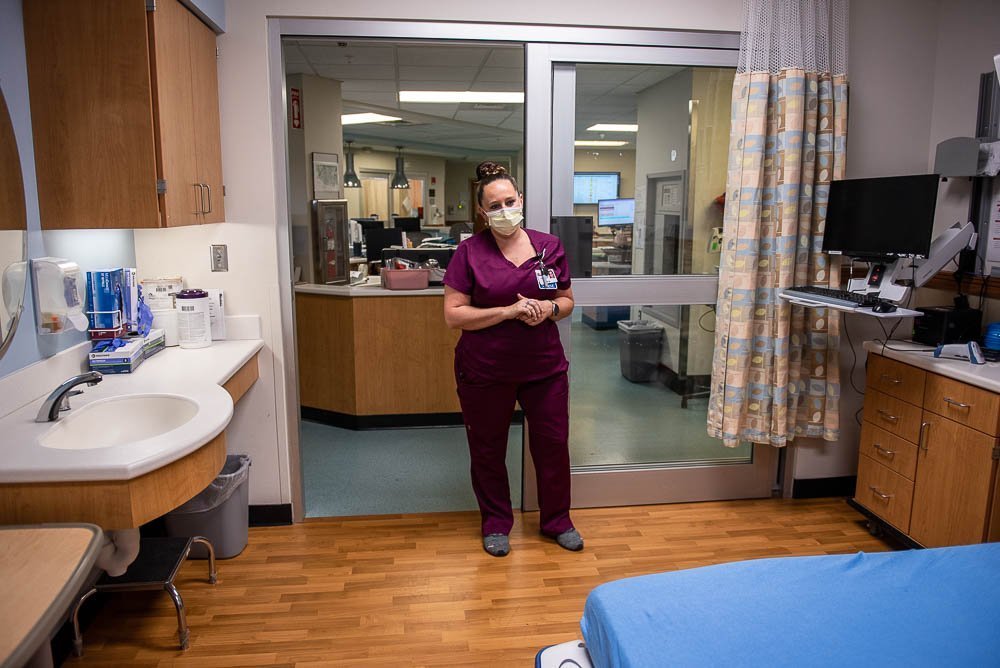Nurse Kristi Dugan demonstrates her medical staff training July 7 to keep herself between a potentially violent patient and a door at St. Mary’s Regional Medical Center in Lewiston. Andree Kehn/Sun Journal
The pandemic showed us how much we rely on hospital workers for our care. It also reminded everyone how much abuse they take in providing it.
The Sun Journal this month reported on a rise in assaults at two hospitals in Lewiston. Earlier this year, nurses at Maine Medical Center in Portland protested over, among other things, workplace violence.
Violence in hospitals has been a problem for some time. COVID just made it impossible to ignore. A legislative task force is looking at how perpetrators can be held responsible criminally.
But just as there is more to the escalating violence than the stress and isolation of the pandemic, it can’t be solved only through more arrests and prosecutions.
The reporting from the Sun Journal shows why there isn’t just one answer.
At St. Mary’s Regional Medical Center, there were about five times as many assaults on staff members in 2021 as there were in 2019. At Central Maine Medical Center, security interventions were up by about a third in that time period.
COVID and the accompanying pandemic were certainly part of the reason. Hospitals were dealing with more critically ill patients, and more worried family members, than before, all with the increased stress of COVID protocols, as well as the staff burnout that got worse as the pandemic stretched on.
But, mostly, the pandemic just added stress to an already stressed-out system – one that well before COVID-19 dropped far too many problems at the feet of hospital workers, without the resources to deal with them.
Hospital emergency rooms are the place of last resort. People who cannot get help elsewhere in our expensive, fragmented health care system end up there when things get really bad.
So hospitals get people who are very sick with untreated illness and injury. They get people whose mental health or substance use has deteriorated because they can’t afford care, or it because it simply isn’t available, and now they are in crisis.
They get people who are in pain and discomfort, who are scared and confused, then are usually forced to wait extended times for care – the result of staffing shortages that also mean hospital workers are in a volatile environment without enough help.
The results are unacceptable.
“They have been kicked, hit, spit upon and concussed at the hands of patients they are there to care for,” a union official representing nurses at Maine Medical Center in Portland said earlier this year.
And while the violence has gotten worse during the pandemic, it was increasingly becoming part of the job well before that. According to the U.S. Bureau of Labor Statistics, health care workers endured 73 percent of nonfatal workplace injuries and illnesses due to violence in 2018. In 2014, a Boston TV station reported on the uptick of violence at hospitals there.
No, violence against hospital workers is not rooted in the pandemic, and it won’t go away just because COVID is becoming less severe.
Nurses certainly need every resource to deal with troublesome patients, and in some instances prosecuting offenders may work to reduce violence.
But neither gets to the heart of the problem: a health care system that fails to treat people until they are in crisis.
Until people can get the care they need when they need it, they’ll keep falling into crisis, with the hospital as the only place to go – and hospital workers will continue to suffer for it.
Related Stories




















Invalid username/password.
Please check your email to confirm and complete your registration.
Use the form below to reset your password. When you’ve submitted your account email, we will send an email with a reset code.